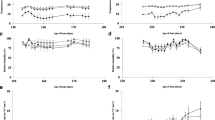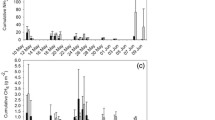Abstract
Limited data are available on ammonia (NH3), nitrous oxide (N2O), carbon dioxide (CO2) and methane (CH4) emissions from poultry housing in Mediterranean countries. The aim of the present study was to assess the NH3, N2O, CO2 and CH4 emission rates from commercial breeding hen and broiler houses under Mediterranean climate conditions. Research was conducted at one commercial breeding hen house and in two commercial broiler houses located in central Portugal. The environmental conditions, gas concentrations and ventilation rates were measured in the cold (8.0 ± 2.1 °C) and hot (20.7 ± 1.9 °C) season for the breeding hen house, whereas for the two broiler houses, measurements were made during one fattening cycle in the fall (17.3 ± 1.7 °C) season. Results showed that the annual average emission rates for breeding hen and broiler houses were 0.52 ± 0.27 and 0.06 ± 0.01 for NH3, 0.030 ± 0.042 and 0.006 ± 0.001 for N2O, 169.6 ± 56.2 and 58.0 ± 15.1 for CO2 and 0.092 ± 0.131 and 0.0113 ± 0.0002 g day−1 bird−1 for CH4, respectively. The N2O emission rates observed in breeding hen houses may have been overestimated, being higher than previously reported for Mediterranean countries.







Similar content being viewed by others
References
Alberdi, O., Arriaga, H., Calvet, S., Estellés, F., & Merino, P. (2016). Ammonia and greenhouse gas emissions from an enriched cage laying hen facility. Biosystems Engineering, 144, 1–12.
Bittman, S., Dedina, M., Howard, C. M., Oenema, O., & Sutton, M. A. (Eds.). (2014). Options for ammonia mitigation: guidance from the UNECE Task Force on Reactive Nitrogen. Edinburgh, UK: Centre for Ecology and Hydrology.
Broucek, J. (2018). Nitrous oxide release from poultry and pig housing. Polish Journal of Environmental Studies, 27, 467–479.
Brouček, J., & Čermák, B. (2015). Emission of harmful gases from poultry farms and possibilities of their reduction. Ekológia (Bratislava), 34, 89–100.
Calvet, S., Cambra-López, M., Estellés, F., & Torres, A. G. (2011). Characterization of gas emissions from a Mediterranean broiler farm. Poultry Science, 90, 534–542.
Chadwick, D. R., Sneath, R. W., Phillips, V. R., & Pain, B. F. (1999). A UK inventory of nitrous oxide emissions from farmed livestock. Atmospheric Environment, 33, 3345–3354.
CIGR. (2002). 4 th Report of Working Group on Climatization of Animal Houses. Horsens, Denmark: International Commission of Agricultural Engineering (CIGR) 45 pp.
Eugene, B., Moore, P. A., Li, H., Miles, D., Trabue, S., Burns, R., & Buser, M. (2015). Effect of alum additions to poultry litter on in-house ammonia and greenhouse gas concentrations and emissions. Journal of Environmental Quality, 44, 1530–1540.
Fabbri, C., Valli, L., Guarino, M., Costa, A., & Mazzotta, V. (2007). Ammonia, methane, nitrous oxide and particulate matter emissions from two different buildings for laying hens. Biosystems Engineering, 97, 441–455.
Guiziou, F., & Béline, F. (2005). In situ measurement of ammonia and greenhouse gas emissions from broiler houses in France. Bioresource Technology, 96, 203–207.
Hassouna, M., Robin, P., Charpiot, A., Edouard, N., & Méda, B. (2013). Infrared photoacoustic spectroscopy in animal houses: effect of non-compensated interferences on ammonia, nitrous oxide and methane air concentrations. Biosystems Engineering, 114, 318–326.
Hayes, E. T., Curran, T. P., & Dodd, V. A. (2006). Odour and ammonia emissions from intensive poultry units in Ireland. Bioresource Technology, 97, 933–939.
IPCC. (2006). 2006. IPCC guidelines for national greenhouse gas inventories. In H. S. Eggleston, L. Buendia, K. Miwa, T. Ngara, & K. Tanabe (Eds.), IPCC national greenhouse gas inventories programme, Technical support unit. Hayama, Japan: IGES http://www.ipcc-nggip.iges.or.jp.
Jugowar, J. L., Rzeźnik, W., & Mielcarek, P. (2017). Emission of ammonia, nitrous oxide and methane from hen house in deep litter/slatted floor system. Journal of Research and Applications in Agricultural Engineering, 62, 64–69.
Lin, X., Zhang, R., Jiang, S., El-Mashad, H., & Xin, H. (2017). Emissions of ammonia, carbon dioxide and particulate matter from cage-free layer houses in California. Atmospheric Environment, 152, 246–255.
Méda, B., Hassouna, M., Aubert, C., Robin, P., & Dourmad, J. Y. (2011). Influence of rearing conditions and manure management practices on ammonia and greenhouse gas emissions from poultry houses. World’s Poultry Science Journal, 67, 441–456.
Méda, B., Hassouna, M., Lecomte, M., Germain, K., Dourmad, J.-Y., & Robin, P. (2015). Influence of season and outdoor run characteristics on excretion behaviour of organic broilers and gaseous emissions. Biosystems Engineering, 139, 35–47.
Misselbrook, T.H., Gilhespy, S.L., Cardenas, L.M., Williams, J., Dragosits, U., (2016). Inventory of ammonia emissions from UK agriculture 2015. DEFRA contract SCF0102, UK, 36 pp.
Naseem, S., & King, A. J. (2018). Ammonia production in poultry houses can affect health of humans, birds, and the environment-techniques for its reduction during poultry production. Environmental Science and Pollution Research, 25, 15269–15293.
Ngwabie, N. M., Acobta, A. N., Manga, V. E., & VanderZaag, A. C. (2018). Emission factors of greenhouse gases from layer and broiler barns in Cameroon. Atmospheric Environment, 176, 54–59.
Nimmermark, S., Gustafsson, G., (2005). Influence of temperature, humidity and ventilation rate on the release of odor and ammonia in a floor housing system for laying hens. Agricultural Engineering International: the CIGR Ejournal. Vol. VII. Manuscript BC 04 008.
Pereira, J. L. S. (2017). Assessment of ammonia and greenhouse gas emissions from broiler houses in Portugal. Atmospheric Pollution Research, 8, 949–955.
Pereira, J. L. S., Ferreira, S., Garcia, C. S. P., Conde, A., Ferreira, P., Pinheiro, V., & Trindade, H. (2017). Assessment of ammonia and carbon dioxide concentrations in a breeding hen building under Portuguese winter. International Journal of Food and Biosystems Engineering, 5, 1–6.
PIIR. (2018). Portuguese informative inventory report 1990-2016. Submitted under the NEC directive (EU) 2016/2284 and the UNECE convention on long-range transboundary air pollution. Lisbon, Portugal: Portuguese Informative Inventory Report (PIIR), Portuguese Environmental Agency 616 pp.
REAP. (2013). Decree number 81/2013 of 14 June regarding animal manure management (REAP). In: Diário da República, Série I, number 113 of 14 June 2013. Portugal, pp. 3304–3329.
Roumeliotis, T. S., Dixon, B. J., & Van Heyst, B. J. (2010). Characterization of gaseous pollutant and particulate matter emission rates from a commercial broiler operation. Part I: Observed trends in emissions. Atmospheric Environment, 44, 3770–3777.
Shepherd, T., Zhao, Y., Li, H., Stinn, J. P., Hayes, M. D., & Xin, H. (2015). Environmental assessment of three egg production systems—part II. Ammonia, greenhouse gas, and particulate matter emissions. Poultry Science, 94, 534–543.
Simsek, E., Kilic, I., Yaslioglu, E., & Arici, I. (2013). The effects of environmental conditions on concentration and emission of ammonia in chicken farms during summer season. Clean Soil, Air, Water, 41, 955–962.
Sommer, S. G., Zhang, G. Q., Bannink, A., Chadwick, D., Misselbrook, T., Harrison, R., Hutchings, N. J., Menzi, H., Monteny, G. J., Ni, J. Q., Oenema, O., & Webb, J. (2006). Algorithms determining ammonia emission from buildings housing cattle and pigs and from manure stores. Advances in Agronomy, 89, 261–335.
Acknowledgments
This work was supported by: European Investment Funds by FEDER/COMPETE/POCI - Operational Competitiveness and Internationalisation Programme, under project POCI-01-0145-FEDER-006958, project Ovislab ICT-2013-05-004-5314 ID-64757, project POCI-01-0247-FEDER-003430 AMONIAVE and National Funds by FCT - Portuguese Foundation for Science and Technology, under the project UID/AGR/04033/2013 and Portugal2020. The authors acknowledge Pedro Ferreira, João Borges and André Conde (LUSIAVES) for the facilities and technical data, as well as the reviewer for their comments and suggestions.
Author information
Authors and Affiliations
Corresponding author
Additional information
Publisher’s Note
Springer Nature remains neutral with regard to jurisdictional claims in published maps and institutional affiliations.
Rights and permissions
About this article
Cite this article
Pereira, J.L.S., Ferreira, S., Pinheiro, V. et al. Ammonia, Nitrous Oxide, Carbon Dioxide and Methane Emissions from Commercial Broiler Houses in Mediterranean Portugal. Water Air Soil Pollut 229, 377 (2018). https://doi.org/10.1007/s11270-018-4026-4
Received:
Accepted:
Published:
DOI: https://doi.org/10.1007/s11270-018-4026-4




